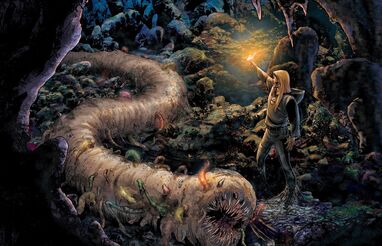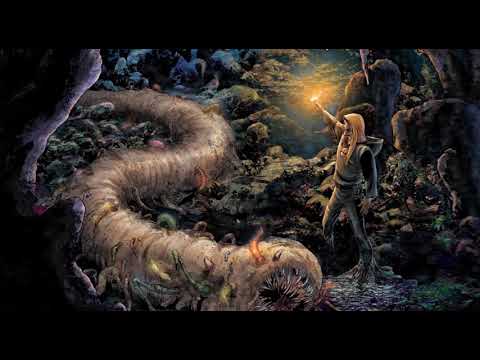No edit summary Tag: Visual edit |
No edit summary Tag: Visual edit |
||
| (One intermediate revision by the same user not shown) | |||
| Line 29: | Line 29: | ||
== Reception == |
== Reception == |
||
In 2020, the [https://vokpodcast.com/ Vassals of Kingsgrave] podcast released a review of ''In the House of the Worm'': |
In 2020, the [https://vokpodcast.com/ Vassals of Kingsgrave] podcast released a review of ''In the House of the Worm'': |
||
| + | [[File:"In the House of the Worm" by George R. R. Martin (Review) - Bastards of Kingsgrave Ep.83|none|thumb|480x480px]] |
||
| − | |||
| + | <br /> |
||
| − | https://www.youtube.com/watch?v=1OrbmHXrcBE |
||
== Connections to the "Thousand Worlds" Universe == |
== Connections to the "Thousand Worlds" Universe == |
||
Latest revision as of 01:42, 22 March 2021
In the House of the Worm is a science-fiction novella by George R. R. Martin, first published in The Ides of Tomorrow: Original Science Fiction Tales of Horror in 1976. It takes place in the "Thousand Worlds" universe, and is set on an unknown planet during the Interregnum period. It is about a young man who lives a life of privilege in a crumbling underground city. When he is humiliated at the hands of a crafty hunter, he and his high-born friends plot revenge.
Plot Summary
— WARNING: THIS SECTION CONTAINS SPOILERS —
The people of the Yaga-la-hai dwell in the ruins of an underground city, deep beneath the uninhabitable surface of the planet. They worship the mythical White Worm and feast in its honour. One day, an arrogant youth named Annelyn and his friends, Varmyllar and Riess, are humiliated by a man known as the Meatbringer. The Meatbringer roams the lower levels of the planet to hunt monsters called grouns for the people to eat.
Annelyn leads his friends into the tunnels on a mission to slay the Meatbringer. Like many teenage quests, Annelyn's was conceived with more bluster than bravery, but, at the point when he was counting on his friends to draw him back from danger, he instead finds one of his people's greatest warriors coming to aid him in the slaying of the Meatbringer. What follows is a descent into the unknown, and, in no time at all, Annelyn is fleeing for his life in pitch black tunnels, hunted by grouns and worms and worse.
— END OF SPOILERS —
Themes

Artwork by Ivan Rodriguez, from the graphic novel edition of In the House of the Worm
The phrase "free-thinker" is repeated several times throughout In the House of the Worm. When Annelyn uses the term to describe himself, the Meatbringer retorts that he as actually immature and conformist. The Meatbringer also mocks the religious customs of the Yaga-la-hai and their unquestioning obedience to the Manworm, whom he claims should pitied rather than praised. The story can be interpreted as one in which Annelyn undergoes a journey of discovery, uncovering the truth of his word's history and his people's relationship to the groun. The descriptions of character's descending through the earth suggests a passage beneath the superficial facade of reality, while the worm tunnels they trek evoke the established grooves of thought and knowledge, from which they must struggle to break free. In the House of the Worm inverts the parable of Plato's Cave, suggesting that the truth does not lie outside the cave in the light, but in fact lies deeper in the cave, deeper in the darkness.
The religion of the Manworm may seem strange and grotesque to the reader, but in many ways it reflects the strangeness and grotesqueness of real-world religions. For example, consider the icon of the amputated Manworm, his pain endured for the purpose of spiritual purity and epiphany; then compare it to the icon of Christianity, Jesus Christ mutilated and dying on the cross, his pain endured as penance for the sins of humanity.
While the story reveals the falsity of certain Yaga-la-hai beliefs, it also shows how religion can still nourish inner strength. For example, after getting lost in the tunnels, Annelyn recites the worship words of the White Worm, which energises him and encourages him to keep searching. Regardless of whether the content of this prayer is literally true, it still contains meaning to Annelyn and helps him survive his ordeal. Therefore, it had a real effect on the world.
Author's Notes
Publication History
In the House of the Worm was first published in the anthology, The Ides of Tomorrow: Original Science Fiction Tales of Horror, edited by Terry Carr, in 1976.
It was included in Martin's short story collections Sandkings, published in 1981, and Songs the Dead Men Sing, published in 1983.
Adaptations
In 2015, In the House of the Worm was adapted into a graphic novel by John Jos. Miller and Ivan Rodriguez.
In 2016, an audiobook version of In the House of the Worm was released by YouTuber Preston Jacobs:

"In the House of the Worm" by George R. R. Martin (audiobook)
Reception
In 2020, the Vassals of Kingsgrave podcast released a review of In the House of the Worm:

"In the House of the Worm" by George R. R. Martin (Review) - Bastards of Kingsgrave Ep.83
Connections to the "Thousand Worlds" Universe
The gold theta, the symbol of the Federal Empire's Ecological Warfare Corps, has been appropriated by the Yaga-la-hai culture and appears several times throughout the story. The Meatbringer recounts the grouns' memories of "changemasters," which may be a reference to the Prometheans, who waged biological warfare against the Hrangans on behalf of the Federal Empire. Additionally, Annelyn's recitation of White Worm prayer includes the phrase "the ships are gone," implying that space vessels were once docked on the planet. The hostile conditions of the planet's surface, and the gigantic worms and humanoid grouns which inhabit it, may be a result of the biological attacks carried out during the Double War. Indeed, the grouns may even be one of the non-men species developed by the Prometheans to fight the underground Hrangan minds.
Allusions to Other GRRM Works
In the House of the Worm shares narrative elements with an earlier short story by Martin. Published in 1973, Dark, Dark were the Tunnels is set on earth after a nuclear war, and depicts extraterrestrial human scientists excavating the planet and discovering a mutated species of humans dwelling far beneath the planet's surface. This premise echoes the relationship between the human Yaga-la-hai, and the lower-dwelling, eyeless grouns, in In the House of the Worm. Both stories feature post-apocalyptic worlds and human beings mutated by biological warfare and subterranean evolution. Both stories also feature giant, carnivorous worms as a mutual enemy of the two groups, and a desire among characters to end their feud and ally against the worms. In the House of the Worm is a much longer story, and Martin seems to use it to develop the concepts he broached in Dark, Dark were the Tunnels.